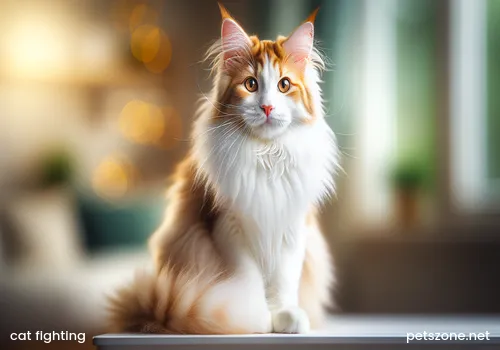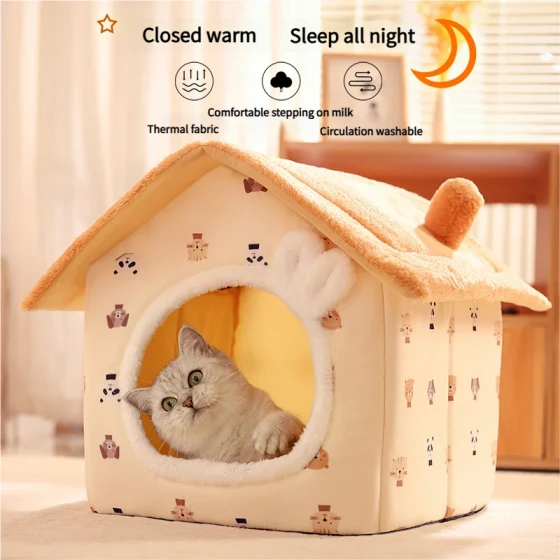How to Judge Two Cats Fighting_How to Tell Which Cat Is in a Weak Position
Judging whether two cats are truly fighting or just playing, and how to tell which cat is in a weak position, can mainly be distinguished by observing the cats' body language, sounds, and interaction patterns. Generally speaking, when cats play, their bodies are more relaxed, movements are reciprocal, and they rarely make aggressive sounds; while in a real fight, the body will be tense, they emit hissing, growling, and other sounds, their attacks are more harmful, and there is usually a clear dominance and weakness distinction.

Many cat owners who have two or more cats are often confused by their cats’ scuffles: “Are they really fighting or just playing?” After all, it's normal for cats to communicate through physical interaction. However, if play escalates into true fighting, it can not only cause injuries but also affect their relationship and psychological health. Understanding how to distinguish between play and fighting, and identifying the weaker cat’s behaviors, is crucial for maintaining harmony in multi-cat households.
How to Judge If Cats Are Playing or Fighting?
To distinguish whether cats are playing or fighting, we need to act like "Sherlock Holmes" and carefully observe the "crime scene" by focusing on their body language, sounds, and interaction patterns.
1. Observe Body Language
Body language is the "weather gauge" of their inner world.
- During Play: The body is usually relaxed, movements are smooth and elastic. Ears may face forward or slightly backward but not completely flattened against the head. The tail might move slightly or even stand up, overall posture is calm and comfortable. They may take turns chasing and pouncing, even exposing their bellies (which typically shows they feel safe and relaxed). Playful bites usually don’t cause real harm, and claws are often retracted.
- During Fighting: The whole body muscles are tense, posture stiff. Ears will be flattened backward or pressed tightly against the head, signaling threat or anger. Fur may stand on end, especially on the tail and back, making them appear larger to intimidate the other cat. The tail may whip rapidly or be held low. Eyes are very sharp, pupils may be dilated or constricted, staring intensely at the opponent.
2. Listen to Sounds
The sounds cats make can also provide vital clues.
- During Play: Usually quiet, if making sounds, they are gentle meows or happy purring. Sometimes short, clicking-like hunting sounds may be heard when they get excited.
- During Fighting: They produce distinct aggressive sounds such as deep growling, sharp hissing, or wailing noises like a child crying. These sounds are usually prolonged and threatening.
3. Analyze Interaction Patterns
The way they interact is also key.
- During Play: Interaction is mutual with back and forth exchanges. One cat chases the other and then they may switch roles. Pouncing and wrestling happen in turns, not always the same cat being dominated or fleeing. There might be short pauses to rest before continuing.
- During Fighting: Interaction is often one-sided, usually one cat actively attacks or chases the other, while the victim tries to flee or defend. Attacks are more persistent and purposeful, possibly involving throat holds or powerful hind kicks aiming to cause harm. After brief separations, the fight may immediately resume.
How to Tell Which Cat Is in a Weak Position?
In the world of cats, social hierarchy objectively exists, especially in multi-cat households. The weaker cat often shows certain behaviors to avoid conflict or signal submission.
1. "Yielding" Body Language
The weaker cat’s body language tends to appear more "low-key" and defensive when facing a stronger cat.
- Posture: May crouch low, trying to appear less conspicuous. The tail might droop or tuck between legs, showing less confidence. They try to keep all four paws on the ground, ready to flee at any moment, and are unlikely to relax by rolling over or exposing their belly (unless showing extreme submission).
- Ears and Eyes: Ears may point sideways or backward, but not fully flattened like in a fight; more of an uncertain or cautious stance. Their gaze may avoid direct eye contact with the dominant cat or appear somewhat evasive.
2. Behavioral "Avoidance"
The weaker cat will try to avoid direct confrontation with the dominant cat.
- Giving Way: In narrow spaces or passageways, the weaker cat typically yields and lets the dominant cat pass first.
- Not Competing for Resources: When eating, drinking, using the litter box, or competing for favorite toys, the weaker cat often retreats, waiting until the dominant cat finishes before approaching. It may watch cautiously from the side.
- Hiding: When stressed or scared, the weaker cat may choose to hide, for example under furniture or in high places, attempting to stay away from stressful environments or individuals.
- Being Groomed: In some cat groups, lower-ranking cats may be groomed by higher-ranking cats, which can be a way to establish hierarchy.
3. Defensive and Submissive Signals During Fighting
If in a fight, the weaker cat will show clear defensive and submissive signals.
- Consistently on the Losing Side: If one cat is constantly chased, dominated, or emits cries of pain or fear during fights, it is likely the weaker one.
- Exposing the Belly (Extreme Submission): In rare cases, when a cat feels completely unable to resist, it may suddenly roll over showing its belly. This is generally regarded as an extreme "I surrender" signal because it reveals the most vulnerable part. However, this is not the relaxed belly exposure seen during play but accompanied by tension and anxiety.
- Avoiding the Victor After the Fight: After fighting, the weaker cat usually avoids the winner, possibly hiding to prevent further conflict. The defeated cat may remember this loss and be more cautious around the dominant cat in the future.
When Is Human Intervention Needed?
Although occasional scuffles are normal cat social behavior, owners need to intervene timely if the following occur:
- Loud fighting sounds with continuous hissing, growling, or cries of pain.
- Cats using claws trying to cause injury, or visible bite, scratch wounds, or bleeding.
- Large amounts of fur flying off during the fight.
- One cat is continuously attacked and chased with no chance to fight back or escape.
- After fighting, cats remain tense, avoidant, or stressed for a long time and do not behave normally.
- Household behavior issues arise such as inappropriate urination or scratching, possibly indicating excessive stress.
If intervention is needed, do not try to pull fighting cats apart with your hands to avoid getting injured. Instead, try making sudden noises (like clapping hands or throwing a cushion near them) or use items like cardboard to separate and distract them.
Frequently Asked Questions
- Q: What to do if cats bleed during a fight?
A: If a cat is injured and bleeding during a fight, separate them immediately and check the wound. If it's deep or bleeding continues, promptly take the cat to the vet to prevent infection. - Q: How to improve relationships between cats?
A: Improving relationships in multi-cat homes requires time and patience. Try increasing and spreading out resources (food bowls, water dishes, litter boxes, scratching posts, resting areas) to reduce competition. Provide each cat with enough individual space. Introduce new cats gradually. Using feline pheromone products can help ease tension. - Q: Is it normal for cats to occasionally hiss while playing?
A: Occasionally short hissing during play may indicate excitement or setting boundaries. If it’s not continuous or aggressive hissing and body language plus interaction suggest playing, it is usually not a concern. Frequent hissing or accompanying stress signs may mean play is too intense and intervention is needed. - Q: Why do some cats always bully another cat?
A: Bullying among cats can stem from resource competition, establishing hierarchy, or personality. If bullying is persistent and the weaker cat is under constant stress, owners should intervene by improving the environment, increasing resources, and diverting attention. Consulting a pet behaviorist may be necessary.
Conclusion
Owning cats is like managing a small "society" full of fun and challenges. Learning to distinguish whether they are playing friendly or seriously "facing off," and identifying the "weaker group," not only helps better care for their physical health but also maintains their mental balance. Hopefully, this article helps cat owners understand their furry kids better and make multi-cat homes more harmonious and loving!


-560x560.webp)
